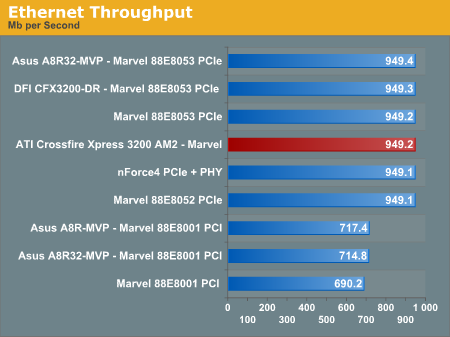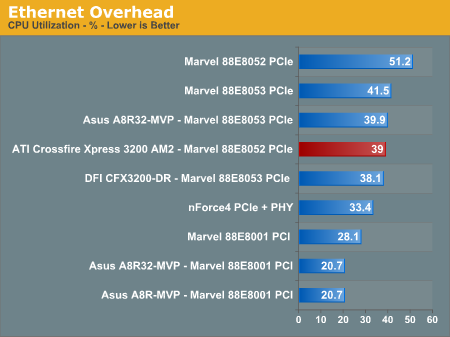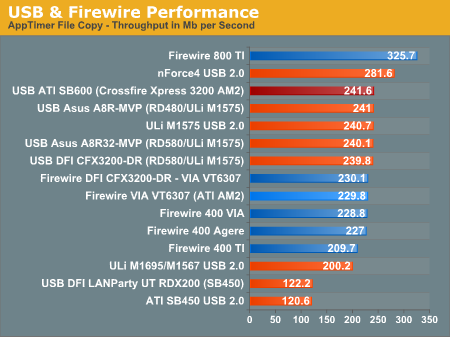CrossFire Xpress 3200: RD580 for AM2
by Wesley Fink on June 1, 2006 12:05 AM EST- Posted in
- Motherboards
Network
The Windows 2000 Driver Development Kit (DDK) includes a useful LAN testing utility called NTttcp. We used the NTttcp tool to test Ethernet throughput and the CPU utilization of the various Ethernet Controllers used on the AMD motherboards.
We set up one machine as the server; in this case, an Intel box with an Intel CSA Gigabit LAN connection. Intel CSA has a reputation for providing fast throughput and this seemed a reasonable choice to serve our Gigabit LAN clients. At the server side, we used the following Command Line as suggested by the VIA whitepaper on LAN testing:
On the client side (the motherboard under test), we used the following Command Line:
At the conclusion of the test, we captured the throughput and CPU utilization figures from the client screen.


The PCIe Gigabit LAN on the ATI is capable of about 35% faster speed than the performance we have measured with PCI Gigabit LAN used on some motherboards. ATI provides a single Marvell PCIe Gigabit controller, compared to dual Gigabit LAN on the competing NVIDIA 590 chipset. All of the on-board PCIe Ethernet controllers seem to exhibit high CPU utilization, but you should keep in mind that the CPU usage we measure is an extremely artificial number which measures the worst case of a continuous Gb transmission. With broad-band connections needing no more than 100Mb Ethernet, the real-world CPU usage will be much lower than these test results. Throughput and CPU utilization for the ATI AM2 were competitive with results from other boards.
USB and Firewire Performance
USB has been a problem area for the ATI SB450 chipset, but it has not been a major issue with the ULi M1575 Southbridge. To test performance of USB and Firewire on the ATI CrossFire Xpress 3200 AM2 we ran our standard USB throughput test using an external USB hard drive. For Firewire tests an external Firewire 400 or 800 hard disk is used for testing
Our test method uses a RAM disk as our "server" since memory removes almost all overhead from the serving end. We also turn off disk caching on the USB and Firewire side by setting up the drives for "quick disconnect". Our results are then consistent over many test runs.
We used 2GB of fast system memory, set up as a 450MB RAM disk and the balance as system memory. Our stock file is the SPECviewPerf 8.01 install file which is 432, 533, 504 bytes (412.4961MB). After copying this file to our RAM disk, we measure the time for writing from the RAM disk to our external USB 2.0 or Firewire 400 or Firewire 800 drive using an internally developed Windows timing program. The copy times are then converted into Megabits per second (Mb) to provide a convenient means of comparing throughput. Higher rates therefore mean better performance.

A red bar is used for SB600 USB performance and orange bars represent competing chipsets. Blue bars represent Firewire performance.
SB600 lived up to its promise, scoring in the same performance range as competing USB solutions. That is, ATI SB600 is a bit faster than the Uli M1575 in USB 2.0 performance and slightly slower than NVIDIA USB 2.0 performance. At current SB600 performance levels you should see no difference in USB 2.0 performance between NVIDIA and ATI SB600.
ATI chose the excellent VIA VT6307 for Firewire on the reference board. Firewire 400 performance is excellent compared to competing Firewire chips. Keep in mind that the manufacturer can choose whatever Firewire chip they choose to use on NVIDIA and ATI AM2 motherboards. Neither chipset includes native Firewire support.
The Windows 2000 Driver Development Kit (DDK) includes a useful LAN testing utility called NTttcp. We used the NTttcp tool to test Ethernet throughput and the CPU utilization of the various Ethernet Controllers used on the AMD motherboards.
We set up one machine as the server; in this case, an Intel box with an Intel CSA Gigabit LAN connection. Intel CSA has a reputation for providing fast throughput and this seemed a reasonable choice to serve our Gigabit LAN clients. At the server side, we used the following Command Line as suggested by the VIA whitepaper on LAN testing:
NTttcps -m 4, 0, ‹client IP› -a 4 -l 256000 -n 30000
On the client side (the motherboard under test), we used the following Command Line:
NTttcpr -m 4, 0, ‹server IP› -a 4 -l 256000 -n 30000
At the conclusion of the test, we captured the throughput and CPU utilization figures from the client screen.


The PCIe Gigabit LAN on the ATI is capable of about 35% faster speed than the performance we have measured with PCI Gigabit LAN used on some motherboards. ATI provides a single Marvell PCIe Gigabit controller, compared to dual Gigabit LAN on the competing NVIDIA 590 chipset. All of the on-board PCIe Ethernet controllers seem to exhibit high CPU utilization, but you should keep in mind that the CPU usage we measure is an extremely artificial number which measures the worst case of a continuous Gb transmission. With broad-band connections needing no more than 100Mb Ethernet, the real-world CPU usage will be much lower than these test results. Throughput and CPU utilization for the ATI AM2 were competitive with results from other boards.
USB and Firewire Performance
USB has been a problem area for the ATI SB450 chipset, but it has not been a major issue with the ULi M1575 Southbridge. To test performance of USB and Firewire on the ATI CrossFire Xpress 3200 AM2 we ran our standard USB throughput test using an external USB hard drive. For Firewire tests an external Firewire 400 or 800 hard disk is used for testing
Our test method uses a RAM disk as our "server" since memory removes almost all overhead from the serving end. We also turn off disk caching on the USB and Firewire side by setting up the drives for "quick disconnect". Our results are then consistent over many test runs.
We used 2GB of fast system memory, set up as a 450MB RAM disk and the balance as system memory. Our stock file is the SPECviewPerf 8.01 install file which is 432, 533, 504 bytes (412.4961MB). After copying this file to our RAM disk, we measure the time for writing from the RAM disk to our external USB 2.0 or Firewire 400 or Firewire 800 drive using an internally developed Windows timing program. The copy times are then converted into Megabits per second (Mb) to provide a convenient means of comparing throughput. Higher rates therefore mean better performance.

A red bar is used for SB600 USB performance and orange bars represent competing chipsets. Blue bars represent Firewire performance.
SB600 lived up to its promise, scoring in the same performance range as competing USB solutions. That is, ATI SB600 is a bit faster than the Uli M1575 in USB 2.0 performance and slightly slower than NVIDIA USB 2.0 performance. At current SB600 performance levels you should see no difference in USB 2.0 performance between NVIDIA and ATI SB600.
ATI chose the excellent VIA VT6307 for Firewire on the reference board. Firewire 400 performance is excellent compared to competing Firewire chips. Keep in mind that the manufacturer can choose whatever Firewire chip they choose to use on NVIDIA and ATI AM2 motherboards. Neither chipset includes native Firewire support.










71 Comments
View All Comments
Saist - Friday, June 2, 2006 - link
to quote"short life for AM2 dominance before the launch of Conroe"
Um. Anandtech, if you actually do believe that Conroe's performance numbers are going to hold up in multithreaded applications that exceed 4megabytes of cache data, I think you need to redo you're calculations. After intel's showing of Conroe behind closed doors during E3, I think you should also be aware that the performance numbers are not adding up. Intel might finally be competitive, but even when Intel chips have been competitive in the past, AMD chips have won on price. AM2 may not be the only game in town come this fall, but to say it has a short life? Makes me wonder if you actually bothered even asking the game developers what they are getting out of the processors.
JarredWalton - Friday, June 2, 2006 - link
...multithreaded applications that exceed 4megabytes of cache data..."We believe in real world testing. I'm sure there will be applicaitons where AMD still comes out ahead, but synthetic scenarios don't really count. If http://techreport.com/etc/2006q2/woodcrest/index.x...">Intel wins in encoding tests, 3D rendering, gaming, office... and loses in a few specific benchmarks that require lots of memory and low latency RAM access, does it really mean AMD is competitive? I mean, there are still a few specific scenarios where P4 can beat A64, but you don't see us trumpeting those as being representative.
What it comes down to is what most people will get out of each platform, and so far it's looking like a pretty clean sweep for Core Duo 2. Woodcrest vs. Opteron in HPC applications might be a different story (I doubt it), but that's really only relevant if you're running server workloads. As far as pricing, http://images.dailytech.com/nimage/1556_large_conr...">last I saw the $300+ prices of dual core AMD chips are going to have a difficult time competing with $185-$225 Intel chips. Overclocks are also looking promising as well, so a $185 chip running 2.8 GHz will be a force to be reconned with.
R3MF - Friday, June 2, 2006 - link
can you tell me the what and the when of this amzing revelation?Slaimus - Thursday, June 1, 2006 - link
You can run CrossFire on 975X as well. It should be a competitive platform once the new CPUs come out.
Axbattler - Thursday, June 1, 2006 - link
Umm, the article made no mention of the Sil3132 performance on the A8R32-MVP, which I believe is bugged.Trisped - Thursday, June 1, 2006 - link
http://www.anandtech.com/mb/showdoc.aspx?i=2767&am...">http://www.anandtech.com/mb/showdoc.aspx?i=2767&am...First chart, #1 is the Silicon Image 3132 SATA2 (ATI) performance rating.
Axbattler - Thursday, June 1, 2006 - link
I saw that. But if you look at the second graph, the performance of the Sil 3132 in the MSI board is considerably worse than in the ATI reference board.That is still quite usable, but the one from the Asus A8R32-MVP is basically unusable (slower than what modern drives are capable).
Wesley Fink - Thursday, June 1, 2006 - link
We retested Sil3132 on the ATI and some other controllers for this review, and the other 3132 data should have been deleted. Now corrected. We are not aware of the 3132 issue with the A8R32-MVP. The Sil3132 is one of the best SATA2 controllers on the market, and it is a much better performer than the Sil3114.Axbattler - Thursday, June 1, 2006 - link
The result does shown in the review does suggest a solid performance from the Sil3132 controller. However, this is what I have been experiencing:- http://img267.imageshack.us/my.php?image=burst4dh....">http://img267.imageshack.us/my.php?image=burst4dh.... (Sil controller)
- http://img71.imageshack.us/my.php?image=burst27ja....">http://img71.imageshack.us/my.php?image=burst27ja.... (ULi controller)
Two motherboard bioses were tested (0311, 0404), as well as all the drivers from 1.0.9.0 (bundled with the motherboard installation CD, to the latest 1.0.16.0
The poor HDTach performance is reflected in real world application too, gaming loading, file copying are all slowed down to horrendous level.
I believe that Gary was able to replicate this issue (not sure if he eventually found a way around it), although I suppose that based on the result of the other board, it is an issue specific Asus board (perhaps the A8R32-MVP). Is there any chance you could run a test to confirm this?
Very few people in forums that I've visited use the Sil controller, perhaps due to the positioning of the SATA socket (which is actually optimal to where my Raptor is installed: on a 5.25" drive bay).
Trisped - Thursday, June 1, 2006 - link
ATI AM2.jpg is a bit blurry when blown up. You might want to set the camera on the highest quality setting so that doesn’t happen.0X looks like a typo
Why did the Audio Performance charts not have any NVIDIA solutions?